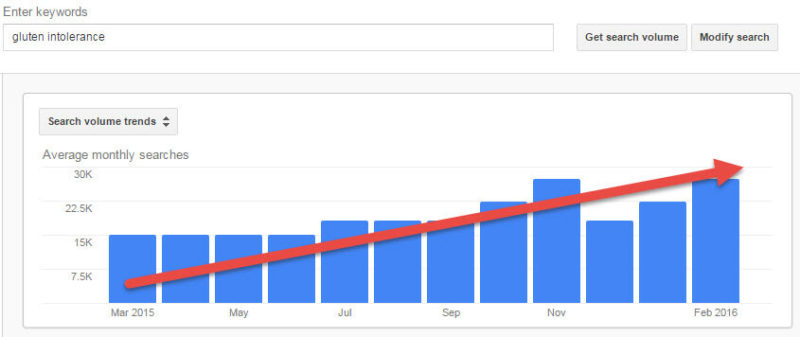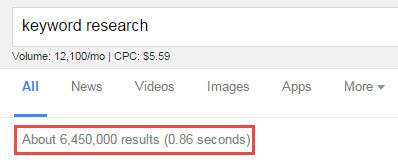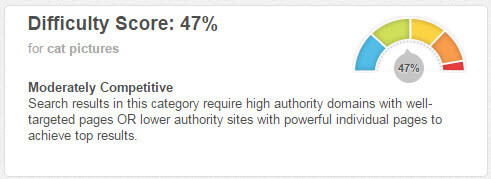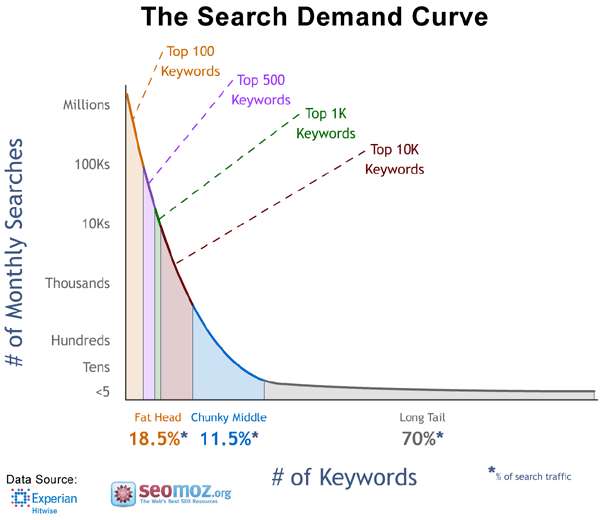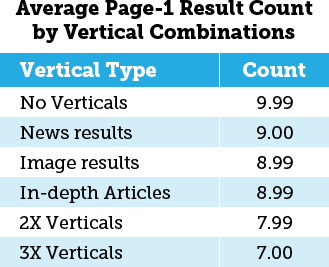The essential metrics to analyze for keyword research success
When it comes time to choose your target keywords, what data should inform your decision? Columnist Paul Shapiro shares some helpful metrics to look at when evaluating which keywords to pursue.

Brainstorming keyword ideas is great, but you won’t get very far if you’re not looking at the right metrics. After all, it’s the metrics — the objective criteria we use to make the data-driven decisions — that make search such an effective marketing channel.
But which keyword research metrics should I be considering? Isn’t search volume sufficient? Let’s explore.
Search volume
Average monthly search volume is the one metric that is universally used for keyword research. This metric is derived from Google’s Keyword Planner, a free tool intended for use with AdWords, and it forms a foundation for the popularity of a given search query.
Typically, one chooses the exact match type for a more precise representation of search volume for a keyword. If your business is regionally locked, make sure to specify a geography to get regional search volume.
Recently, Russ Jones wrote an excellent article on Moz discussing some of the issues with relying on Keyword Planner search volume. Jones found that search volume numbers are actually rounded to the closest of 85 “buckets” and that the 12-month average is also rounded to one of those traffic buckets. To get a more accurate 12-month average, one must segment monthly search volumes and manually average them.
Jones also found that the Keyword Planner doesn’t combine the search volumes of keyword phrases that are auto-corrected to a shared search engine results page (SERP).
To get more out of the search volume metric:
- Choose the exact match type.
- If your site is geographically dependent, choose the appropriate region.
- Manually average the last 12 months of search volumes, rather than relying on Google’s provided 12-month average.
- Group volumes of keyword variants together.
Search volume over time
Another important keyword research metric that is often ignored is how search volume changes over time. Depending on your budget, it may not make sense to invest in content creation for a keyword that won’t capture traffic in a year.
To make this data more useful for decision-making, one would calculate a 12-month average search volume from one year to another, then boil it down to a single positive or negative number using the slope formula.
If you don’t have access to historical search volume records, you can calculate the correlation coefficient for 12 months of search volumes compared to the progression of time. It’s not perfect math, but it works as an approximation.
Suggested bid prices
The Keyword Planner provides a suggested price to bid on keywords in AdWords. It acts as a good approximation for the monetary value of a keyword if you don’t have more accurate cost-per-click (CPC) data.
Number of results
Google has said on numerous occasions that the value it displays for a search indicating the number of results is not an accurate metric.
However, it is still worth looking at if used as an approximation, especially for a query with fewer than average results displayed.
AdWords competition
The Google Keyword Planner provides a competition metric for AdWords. This value is often misused as a metric for indicating the difficulty of ranking within the organic SERP. This metric reflects “number of advertisers that showed on each keyword relative to all keywords across Google.”
The AdWords competition metric isn’t really applicable for SEO due to the difference in AdWords usage and the greater complexity of the organic Google ranking algorithm.
For example, a search for “cat pictures” is very competitive in the organic SERP, but not many people are bidding on it.
If you are more concerned with keyword research for AdWords, by all means use it.
Organic competition/difficulty
A better method of assessing the competitiveness of a search term for SEO purposes is using a metric such as Moz’s Keyword Difficulty percentage or SEMRush’s Keyword Difficulty score. These metrics consider the authority of the other pages ranking in a SERP.
Alternatively, you may choose to create your own competition metric. If you use a rank tracking service that provides the top 10 ranking pages for a keyword, you can find the average Page Authority and/or Domain Authority for those pages and compare it to your own website. If you’re savvy, this can all be done via API.
Search demand curve buckets
The SEO industry has a tendency to throw terms around. When we talk about the search demand curve of keywords, this is no exception.
Instead of assuming that a keyword is “long tail,” plot your keywords on a graph, and bucket them accordingly using actual numeric values.
Estimated first position value metric
We can calculate the approximate monetary value of keyword ranking in the first position fairly easily. To calculate the value, take the average monthly search volume, multiply it by the average CTR for a position 1 ranking, and then multiply by the suggested bid value for AdWords from the Google Keyword Planner. This will yield a value that considers the amount of traffic the first position produces and the amount you’d have to spend on AdWords to achieve a similar result.
KOB metric
The keyword opposition to benefit (KOB) metric, originally conceived by Todd Malicoat, does a decent job of evaluating competition, cost and volume in a single metric value. In its simplest form, we take the estimated first position value metric from above and divide it by a “difficulty” metric, like the percent value from Moz’s Keyword Difficulty Tool.
Recommended Reading: Ross Hudgens recently published this epic guide on how to combine the KOB metric with Brian Dean’s Skyscraper Technique to boost web traffic from SEO.
Match type ratio
AJ Kohn advocates the usage of a match type ratio metric as a proxy to determine whether the intent of a keyword is fractured or uniform. This is achieved by dividing the broad match search volume of a keyword by the exact match search volume of a keyword.
A lower value match type ratio signals that the various searches which include that keyword differ very little in terms of intent. Broader, more ambiguous searches are more likely to have high match type ratios because they require an additional modifier be added to better clarify the intent behind them, thus producing higher broad match search volumes.
Available organic SERP real estate
Traditional organic real estate in Google SERPs varies from query to query (and has been diminishing). Some searches yield answer boxes, while others yield news results, map packs, images or other features within the SERP — all of which seem to reduce the number of traditional organic results down from its original 10. Because of this, available traditional organic SERP real estate should be considered, especially for highly competitive terms.
It’s worth noting that low traditional organic real estate isn’t necessarily a bad thing. It might simply mean that there are opportunities to appear in other parts of the search results if you focus your efforts elsewhere.
Google Display Planner demographics
My colleague, Andrew Ruegger, wrote an article last month about how he uses Google Display Planner in conjunction with KNIME (easily my favorite tool of all time) to pull demographic data for search queries. The data represent the demographics of relevant sites on the Google Display Network, rather than the keywords, but they still provide a reasonable approximation.
If you have an existing website and have access to Experian Hitwise or demographic data in Google Analytics, that may be better. Either way, I highly recommend including demographic data in your keyword research.
Keyword metrics to consider for sites with existing data
Some metrics can only be considered if a website has some age to it, since older websites have had the opportunity to collect some data along the way. If this applies to your site, look into the following:
Current keyword rank
Using a keyword rank tracking tool, or the limited data provided within Google Search Console, is a good way to understand where your website currently stands at the keyword level.
Potential traffic growth
Based on Search Volume, your Current Keyword Rank and your position-based CTR study of choice, you can estimate how much more traffic you would get if you improve your keyword ranking. Use that information to make decisions about where to focus your keyword optimization efforts.
Google Search Analytics Metrics
The following metrics are dependent on data availability from the Search Analytics report within the Google Search Console. Unfortunately, at this point in time, only 90 days’ worth of data is available from Search Analytics.
As a workaround, you can run a script to back up the data to an SQL database to retain historical data. If you aren’t already doing this, you can use my Python script for backing up Search Analytics data to a MySQL database, which works fully with the current version of the API.
- Average monthly organic clicks by keyword: By checking the “Clicks” box at the top of the report screen (This is the default setting), Search Analytics will show you a list of your top-performing keywords, sorted by number of clicks. You can use this to see which keywords are currently performing well and which ones are not.
- Average monthly organic impressions by keyword: Alternatively, you can view impression data per keyword by checking the “Impressions” box at the top of the screen. This metric is useful when used in conjunction with click data to determine which keywords are showing up but getting an insufficient number of clicks. Improving traffic may be as simple as rewriting a meta description in order to improve click-through rate (CTR), moving from impression to click.
Actual average CPC
The suggested bid price provided by Google Keyword Planner isn’t always correct. It’s useful as an approximation, but if you have access to historical PPC bidding, then you can get access to better, more accurate data. Take a look at your actual average CPC if it’s available.
AdWords Quality Score
Again, if you have historical PPC data available, you may want to take a look at Quality Score as a means of assessing the quality of your content on a page-to-keyword level.
Again, it’s not a perfect metric, as the composition of Quality Score is a bit of black box, and not all of the factors may be representative, but it is another example of a good approximation.
Conclusion
Search engine optimization has the ability to be a very data-driven process, with all the data now available. By now, you should have a better sense of the various metrics you can use to improve the effectiveness of your keyword research. Keyword research is more than just search volume. Make your process more useful, and dive deeper with these metrics today!
Contributing authors are invited to create content for Search Engine Land and are chosen for their expertise and contribution to the search community. Our contributors work under the oversight of the editorial staff and contributions are checked for quality and relevance to our readers. The opinions they express are their own.
Related stories
New on Search Engine Land

